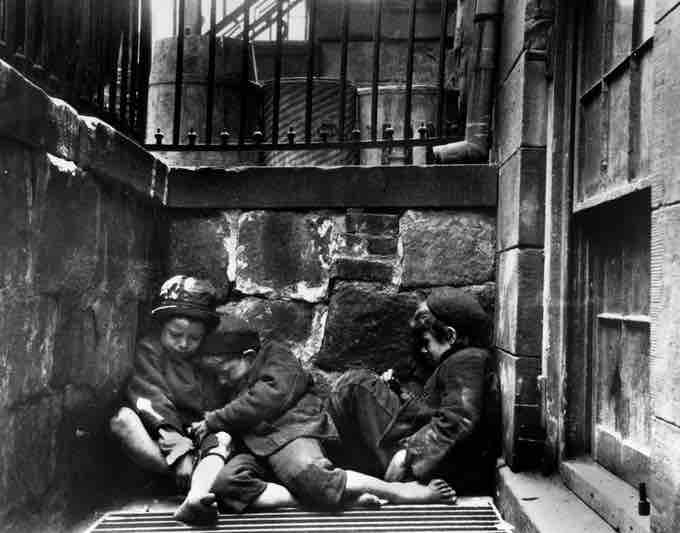The 1890s and early 1900s witnessed a profound social and political reaction to the excesses and corruption of the Gilded Age. Journalists and other writers began bringing social issues to the attention of the American public.
Muckrakers
The term "muckraker" was used during the Progressive Era to characterize reform-minded American journalists who largely wrote for popular magazines. The modern characterization of this type of journalism is "investigative," and investigative journalists today are often informally called "muckrakers." During the Progressive Era, these journalists relied on their own reporting and often worked to expose social ills and corporate and political corruption. Muckraking magazines—notably McClure's—took on corporate monopolies and crooked political machines while raising public awareness of chronic urban poverty, unsafe working conditions, and social issues such as child labor. The term "muckrakers" is a reference to a character in John Bunyan's classic Pilgrim's Progress, "the Man with the Muck-rake," who rejected salvation to focus on filth. The term became popular after President Theodore Roosevelt referred to the character in a 1906 speech; Roosevelt acknowledged that, "the men with the muck rakes are often indispensable to the well-being of society; but only if they know when to stop raking the muck..." The muckrakers themselves proudly adopted the label.
McClure's Magazine
McClure's Magazine (January 1901) published many early muckraker articles.
The muckrakers appeared at a moment when journalism was undergoing changes in style and practice. In response to the exaggerated facts and sensationalism of yellow journalism, objective journalism, as exemplified by The New York Times under Adolph Ochs after 1896, reported facts with the intention of being impartial and a newspaper of record. The growth of wire services also had contributed to the spread of the objective reporting style. Muckraking publishers, such as Samuel S. McClure, emphasized factual reporting but also aimed for a mixture of, "reliability and sparkle" to interest a mass audience. In contrast with objective reporting, muckrakers saw themselves primarily as reformers and were politically engaged. Journalists of the previous eras were not linked to a single political, populist movement, whereas the muckrakers were associated with Progressive reforms. Muckrakers continued some of the investigative exposures and sensational traditions of yellow journalism, but instead wrote to change society.
Julius Chambers
Julius Chambers of the New York Tribune is considered by many to be the original muckraker. Chambers undertook a journalistic investigation of Bloomingdale Asylum in 1872, having himself committed with the help of some of his friends and his newspaper's city editor. His intent was to obtain information about the alleged abuse of inmates. The publication of articles and accounts of the experience in the Tribune led to the release of 12 patients who were not mentally ill, to a reorganization of the staff and administration of the institution, and eventually, to a change in the lunacy laws. This later led to the publication of Chambers's book A Mad World and Its Inhabitants (1876). From this point onward, Chambers was frequently invited to speak about the rights of the mentally ill and the need for proper facilities for their accommodation, care, and treatment.
Jacob Riis
Journalists began to respond to the excesses of the Gilded Age toward the end of the period. One of the most notable was Jacob August Riis (May 3, 1849–May 26, 1914). Riis was a Danish-American social reformer, muckraker, and social documentary photographer. He is well known for using his photographic and journalistic passion to bring attention and aid to New York City's impoverished citizens; they would became the subject of most of his prolific writings and photography. His most famous work, How the Other Half Lives: Studies Among the Tenements of New York (1890) documented squalid living conditions in New York City slums in the 1880s. It served as a basis for future muckraking journalism by exposing New York City’s upper and middle classes to the slums. This work inspired many reforms of working-class housing immediately after publication, and it has continued to have a lasting impact in today's society. With the help of humanitarian Lawrence Veiller, Riis endorsed the implementation of "model tenements" in New York. While living there, Riis's personal experience with poverty led him to become a police reporter, writing about the quality of life in the slums.

Children
Jacob Riis documented the hard life encountered by many immigrants and the poor in the city.
Ida B. Wells
Ida Bell Wells-Barnett (July 16, 1862–March 25, 1931) was an African-American journalist, newspaper editor, and (along with her husband, newspaper owner Ferdinand L. Barnett) an early leader in the civil-rights movement. She documented lynching in the United States, exposing it as a means of controlling and/or punishing blacks who dared compete with whites. She was active in the women's rights and women's suffrage movements, establishing several notable women's organizations. Wells was a skilled, persuasive rhetorician who traveled internationally on lecture tours.
The pamphlets Southern Horrors: Lynch Law in All Its Phases and A Red Record documented her research on a lynching. Having examined many accounts of lynching based on the alleged, "rape of white women," Wells concluded that Southerners concocted rape as an excuse to hide their real motivation for lynchings: black economic progress, which threatened not only white Southerners' pocketbooks, but also their ideas about black inferiority. She wrote an article that suggested that despite the myth that white women were sexually at risk for attacks by black men, most liaisons between black men and white women were consensual.